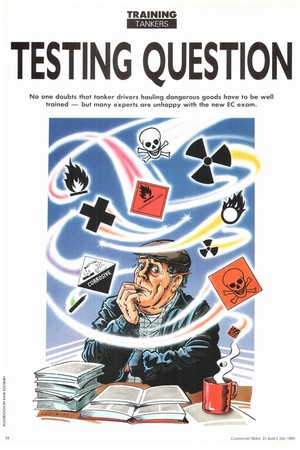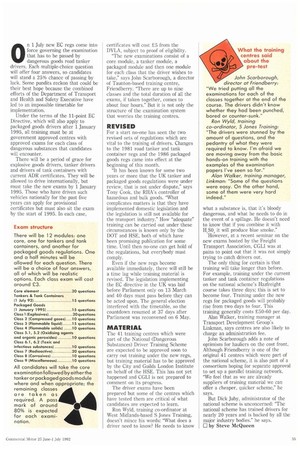TESTING QUESTION
Page 38

Page 39

If you've noticed an error in this article please click here to report it so we can fix it.
No one doubts that tanker drivers hauling dangerous goods have to be well trained — but many experts are unhappy with the new EC exam.
On 1 July new EC regs come into force governing the examination that has to be passed by dangerous goods road tanker drivers. Each multiple-choice question will offer four answers, so candidates will stand a 25% chance of passing by luck. Some pundits reckon that could be their best hope because the combined efforts of the Department of Transport and Health and Safety Executive have led to an impossible timetable for implementation.
Under the terms of the 11-point EC Directive, which will also apply to packaged goods drivers after 1 January 1995, all training must be at government approved centres with approved exams for each class of dangerous substances that candidates will encounter.
There will be a period of grace for explosive goods drivers, tanker drivers and drivers of tank containers with current ADR certificates. They will be allowed to drive internationally, but must take the new exams by 1 January 1995. Those who have driven such vehicles nationally for the past five years can apply for provisional certificates but must also sit the exam by the start of 1995. In each case, certificates will cost E5 from the DVLA, subject to proof of eligibility.
"The new examinations consist of a core module, a tanker module, a packaged module and then one module for each class that the driver wishes to take," says John Scarborough, a director of Taunton-based training centre, Friendberry. "There are up to nine classes and the total duration of all the exams, if taken together, comes to about four hours." But it is not only the structure of the examination system that worries the training centres.
REVISED
For a start no-one has seen the two revised sets of regulations which are vital to the training of drivers. Changes to the 1981 road tanker and tank container regs and the 1986 packaged goods regs came into effect at the beginning of this month.
"It has been known for some two years or more that the UK tanker and packaged goods regulations were under review, that is not under dispute," says Tony Cook, the RHA's controller of hazardous and bulk goods. "What complicates matters is that they have implemented domestic legislation and the legislation is still not available for the transport industry." How "adequate" training can be carried out under these circumstances is known only by the DOT and HSE, both of which have been promising publication for some time. Until then no-one can get hold of the regulations, but everybody must comply.
Even if the new regs become available immediately, there will still be a time lag while training material is revised. The legislation implementing the EC directive in the UK was laid before Parliament only on 13 March and 40 days must pass before they can be acted upon. The general election interfered with the timetable, so the countdown resumed at 37 days after Parliament was reconvened on 6 May.
MATERIAL
The 41 training centres which were part of the National (Dangerous Substances) Driver Training Scheme are expected to be approved soon to carry out training under the new regs, but training material has to be approved by the City and Guilds London Institute on behalf of the HSE. This has not yet happened and CGLI is not prepared to comment on its progress.
The driver exams have been prepared but some of the centres which have tested them are critical of what candidates are expected to learn.
Ron Wyld, training co-ordinator at West Midlands-based S Jones Training, doesn't mince his words: "What does a driver need to know? He needs to know
what a substance is, that it's bloody dangerous, and what he needs to do in the event of a spillage. He doesn't need to know that if you combine it with 11,SO4 it will produce blue smoke."
However, at a recent seminar on the new exams hosted by the Freight Transport Association, CGLI was at pains to point out that it was not simply trying to catch drivers out.
The only thing for certain is that training will take longer than before. For example, training under the current tanker and tank container regulations on the national scheme's Hazfreight course takes three days; this is set to become four. Training under the new regs for packaged goods will probably rise from two days to four. This training generally costs £50-60 per day.
Alan Walker, training manager at Transport Development Group's Linkman, says centres are also likely to charge an administration fee.
John Scarborough adds a note of optimism for hauliers on the cost front. Although Friendberry is one of the original 41 centres which were part of the national scheme, it is also part of a consortium hoping for separate approval to set up a parallel training network. "We feel that as we are already suppliers of training material we can offer a cheaper, quicker scheme," he says.
But Dick Juby, administrator of the national scheme is unconcerned: "The national scheme has trained drivers for nearly 20 years and is backed by all the major industry bodies." he says. DI by Steve McQueen














































































